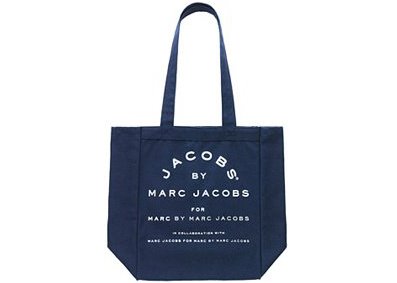On Causes vs Effects and Marc Jacobs

Above: Jacobs by Marc Jacobs for Marc by Marc Jacobs in collaboration with Marc Jacobs for Marc by Marc Jacobs tote.
I was watching this documentary on Marc Jacobs the other day. During a section focusing on his work with contemporary artists and his growing personal collection of art, Jacobs lamented that he was not himself an artist. But his statment seemed odd to me: I had, at least in some sense, always thought of Jacobs as an artist. It was strange to hear him think otherwise. Later, the painter Elizabeth Peyton is interviewed: she considers Jacobs an artist as well, even though she acknowledges that he doesn’t consider himself one. Jacobs’s reasoning for this is that he has investors and bosses at LVMH for his work at Louis Vuitton, and for his work with Marc Jacobs and Marc by Marc Jacobs. The public, of course, has its demands as well. His argument is that he doesn’t enjoy the individual freedom for self-expression that artists enjoy. Even knowing Jacobs’s reasons, however, I still disagreed with him and agreed with Peyton. This got me thinking.
To start, let’s try a little experiment. If I asked you who Marc Jacobs was, I suspect the majority of you would tell me he was an American Fashion Designer, or perhaps just a Fashion Designer. However, having made this categorization, assuming I already knew who Marc Jacobs was and I asked you if you thought he was an artist, I suspect many people would answer “Yes.” Here, then, is a bit of a paradox. Because on the one hand you’ve just told me that Marc Jacobs is a designer, but on the other hand, given the slightest suggestion on my part, you’ve also told me that he’s an artist.
Let’s try another example. If I asked you who Jeff Koons was, I suspect the majority of you would tell me he was an American artist, or perhaps just an artist. However, having made this categorizaiton, assuming I already knew who Jeff Koons was and I asked you if you thought he was a designer, I suspect many people in this room would answer “No.” Curious.
So artists create a snag in this back-and-forth game. What about authors? Who’s Jonathan Safran Foer? He’s an author or a writer. Did he design Everything Is Illuminated? I suspect you’d wrinkle your nose at this turn of phrase and say “No.” Let’s add authors to the list with artists.
What if I told you I made paintings and asked you what you call someone who makes paintings? I suspect most of you would call me an artist. If I made posters? Designer.
What does all this tell us? I believe all creative works can be seen from two sides: the work’s causes and its effects. Marc Jacobs doesn’t have to make clothes in the exact same way that Jonathan Safran Foer writes a book to effect the same kind of change in the public. When we say, for example, that a designer is an author we’re making a metaphor. We are not saying designers are actually authors, unless those designers are writing a book, right? What we’re saying when we call a designer an “author” is that the effects of that designer’s work are like the effects of an author’s writing. Designers don’t author things, but they are like authors when their work produces similar effects.
Creative circumstances often create a trap for serious critical discussions when they appear on the causal side. Because on the causal side, attempts at analogy break down. You keep looking for parallels between the act of authoring and the act of designing. And because you’re forcing a working method you’re less familiar with (but more eager to adopt) to correspond with a working method you’re more familiar with (but more eager to evolve), you always feel like you’re somehow coming up short.
My point is: designers can’t be authors if they play the game on the causal side. So let’s focus on effects. On the effects side, a maker’s status is less relevant – what matters instead is context and medium. Just as we have certain expectations that are hard-wired about professions – painters paint and authors write – we have certain expectations about mediums on the effects side. Sculptures are produced by artists and posters are produced by graphic designers.
What I want to argue, finally, is that, simple as it sounds, designers are designers and designers only on the causal side. But the effects of their work can be similar to those of artists, or authors, or they can be entirely their own. Analogies emerge to help direct creative practitioners toward similar purposes of inspiring, informing, entertaining, and enlightening us.
In order for design discourse to switch from an inventory of causes to an inventory of effects, design must cultivate, welcome, and then listen carefully to a branch of critics who are knowledgable about the design process but whose role is primarily to advocate for design’s effect on its publics. This is starting to happen. When design writing is practiced by design producers like myself, an emphasis is often placed on the way things look and how they get made. While I don’t want to dismiss these topics as trivial, I want to suggest that as pathways into the public’s understanding of design they have been well-travelled. These are some causes of design. What’s worth looking at more and more are its effects.